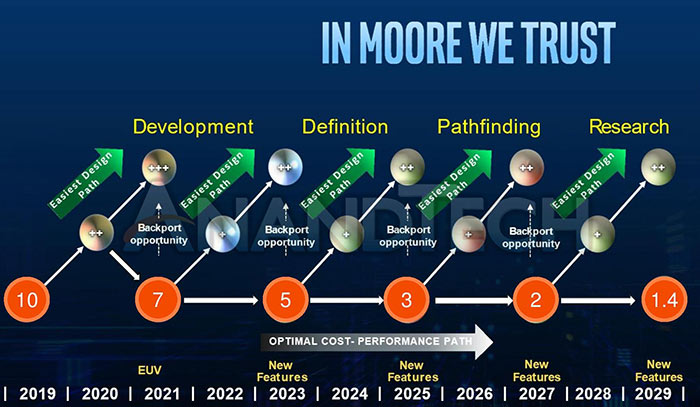Intel semiconductor machinery partner ASML presented at the IEEE International Electron Devices Meeting earlier this week and raised eyebrows with an edited version of an Intel processor scaling roadmap. Intel originally showed off this roadmap back in September. However, ASML made it rather more interesting by clearing the fog and overlaying the nanometer node sizes alongside corresponding years, spanning 2019 through to 2029.

Above you can see the original Intel roadmap slide from September. Below is the ASML edited version superimposing numerals indicating node sizes. As AnandTech notes, people could have extrapolated these from 2019 10nm+, ++ and so on, themselves - but it is good to see it in 'ink'.

Overall the slides represent the intended return to a two year cadence for Intel manufacturing process node upgrades. It shows we are now at 10nm, as far as Intel is concerned, and we will see 7nm EUV in 2021, 5nm and new features in 2023, 3nm in 2025, 2nm in 2027, and the first time we have seen charted or mentioned with respect to Intel: 1.4nm in 2029. This 1.4nm scale means a processor feature could be as small as the length of 12 silicon atoms in a row.
Between each node will be a yearly iterative + version - a 'tock' following the process 'tick', if you like. Furthermore, every node shows an opportunity to back port new process features to the previous node, shown as ++ versions. This can help maintain a smooth flow of product if there are any production issues going forward.

Overall it looks like Intel and ASML are aiming to keep step with Moore's Law for the next decade but this might be more of an optimistic schedule than a cold hard realistic plan. Indeed, beyond 2023 Intel is still in the ‘path-finding’ and 'research' mode, notes AnandTech. Meaning that it is still looking at and assessing new materials, new transistor designs, and so on. To get to 5nm and beyond Intel is considering introducing stacked nanowires and 3D wafer stacking, as highlighted in a presentation by Jim Keller this summer, marking the 50th anniversary of Moore's Law. See the slide above, which seems to chronographically correspond to the slides atop of this article.













